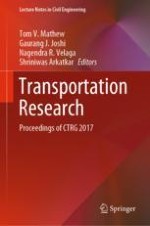2020 | OriginalPaper | Buchkapitel
Comparative Analysis of Pedestrian Walking Speed on Sidewalk and Carriageway
verfasst von : Ninad Gore, Sanjay Dave, Jiten Shah, Manish Jain, Dipak Rathva, Vinay Garg
Erschienen in: Transportation Research
Verlag: Springer Singapore
Aktivieren Sie unsere intelligente Suche, um passende Fachinhalte oder Patente zu finden.
Wählen Sie Textabschnitte aus um mit Künstlicher Intelligenz passenden Patente zu finden. powered by
Markieren Sie Textabschnitte, um KI-gestützt weitere passende Inhalte zu finden. powered by
